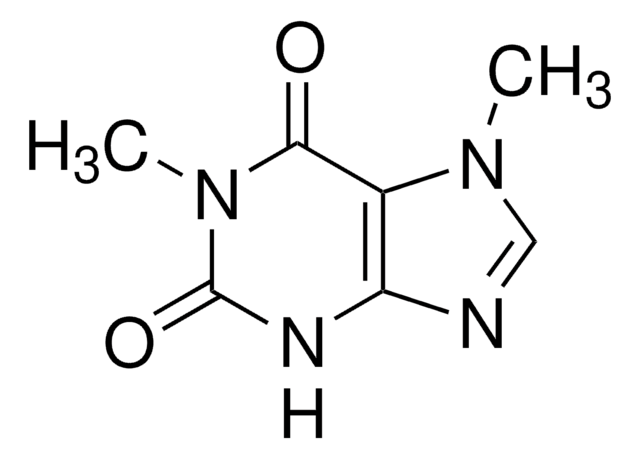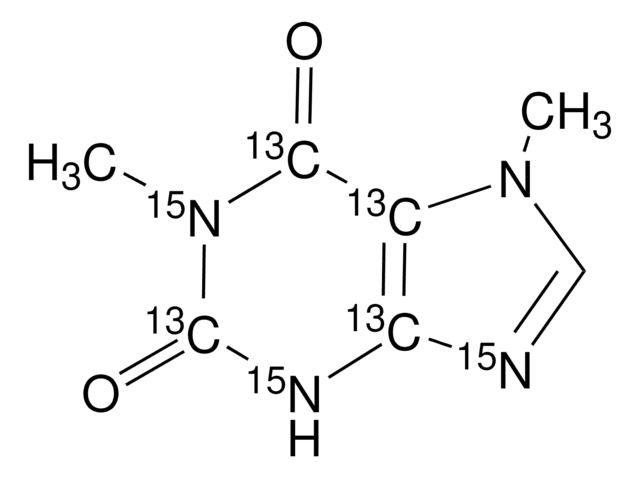Wichtige Dokumente
D5385
1,7-Dimethylxanthin
~98% (TLC), solid, adenosine receptor ligand
Synonym(e):
1,7-Dimethyl-1H-purin-2,6-dion, 1,7-Dimethyl-3,7-dihydro-1H-purin-2,6-dion, 2,6-Dihydroxy-1,7-dimethylpurin, NSC 400018, Paraxanthin
About This Item
Empfohlene Produkte
Produktbezeichnung
1,7-Dimethylxanthin, ~98%, solid
Assay
~98%
Qualitätsniveau
Form
solid
Farbe
white
mp (Schmelzpunkt)
294-296 °C (lit.)
Löslichkeit
ethanol: 0.6 mg/mL
H2O: 1 mg/mL
0.1 M NaOH: 2 mg/mL
SMILES String
CN1C(=O)Nc2ncn(C)c2C1=O
InChI
1S/C7H8N4O2/c1-10-3-8-5-4(10)6(12)11(2)7(13)9-5/h3H,1-2H3,(H,9,13)
InChIKey
QUNWUDVFRNGTCO-UHFFFAOYSA-N
Angaben zum Gen
human ... ADORA1(134) , ADORA2A(135) , ADORA2B(136) , ADORA3(140)
rat ... Adora1(29290) , Adora2a(25369)
Suchen Sie nach ähnlichen Produkten? Aufrufen Leitfaden zum Produktvergleich
Allgemeine Beschreibung
Anwendung
Biochem./physiol. Wirkung
Leistungsmerkmale und Vorteile
Signalwort
Warning
H-Sätze
Gefahreneinstufungen
Acute Tox. 4 Oral
Lagerklassenschlüssel
11 - Combustible Solids
WGK
WGK 1
Flammpunkt (°F)
Not applicable
Flammpunkt (°C)
Not applicable
Persönliche Schutzausrüstung
dust mask type N95 (US), Eyeshields, Gloves
Hier finden Sie alle aktuellen Versionen:
Besitzen Sie dieses Produkt bereits?
In der Dokumentenbibliothek finden Sie die Dokumentation zu den Produkten, die Sie kürzlich erworben haben.
Kunden haben sich ebenfalls angesehen
Artikel
Xanthine is a purine base found in most human body tissues and fluids as well as in other organisms. Methylated xanthines (methylxanthines), which include caffeine, paraxanthine, theobromine, and theophylline, commonly used for their effects as mild stiµlants and as bronchodilators, notably in the treatment of asthma symptoms. This application shows the efficient separation of several common xanthines and may be applied their analysis in any number of desired matrices.
Unser Team von Wissenschaftlern verfügt über Erfahrung in allen Forschungsbereichen einschließlich Life Science, Materialwissenschaften, chemischer Synthese, Chromatographie, Analytik und vielen mehr..
Setzen Sie sich mit dem technischen Dienst in Verbindung.







